Cranfield University
 Cranfield University coat of arms | ||||||||
Former names |
Cranfield Institute of Technology College of Aeronautics | |||||||
|---|---|---|---|---|---|---|---|---|
| Motto |
Latin: Post Nubes Lux; "After clouds light"[1] | |||||||
| Type | Public | |||||||
| Established | 1946, incorporated by Royal Charter and university status in 1969[2][3][4] | |||||||
| Chancellor | Baroness Young of Old Scone | |||||||
| Vice-Chancellor | Sir Peter Gregson [5] | |||||||
Administrative staff | 1,800 | |||||||
| Students |
3,935 (2016/17)[6] (all postgraduates) | |||||||
| Location |
Cranfield, Bedfordshire Shrivenham, Oxfordshire England | |||||||
| Campus | Rural (both) | |||||||
| Colours |
| |||||||
| Affiliations | ACU, PEGASUS | |||||||
| Website | http://www.cranfield.ac.uk/ | |||||||
Cranfield University is a British postgraduate and research-based public university specialising in science, engineering, technology and management. It contains two campuses: the main campus is at Cranfield, Bedfordshire, and the second is at the Defence Academy of the United Kingdom at Shrivenham, southwest Oxfordshire.[7] The main campus is unique in the United Kingdom and Europe for having a semi-operational airport (Cranfield Airport) on campus. Cranfield University owns and operates the airport. The airport facilities are used by Cranfield University's own aircraft in the course of aerospace teaching and research.
Cranfield was founded as the College of Aeronautics in 1946. Through the 1950s and 1960s, the development of many aspects of aircraft research and design led to considerable growth and diversification into other areas such as manufacturing and management. In 1967, the Cranfield School of Management was founded. In 1969, the College of Aeronautics became The Cranfield Institute of Technology incorporated by Royal Charter and gained degree awarding powers and became a university in its own right.[2][3][4] In 1993, it adopted its current name - Cranfield University.[2][3][4]
Cranfield University's motto, 'post nubes lux', means 'after clouds light'. It is depicted on the Cranfield University coat of arms which was introduced when the University was awarded its Royal Charter.[8]
History
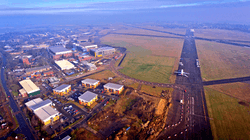
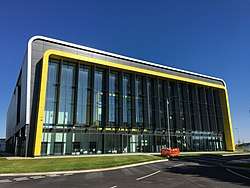
College of Aeronautics (1946-1969)
Cranfield University was formed in 1946 as the College of Aeronautics, on the then Royal Air Force base of RAF Cranfield. A major role was played in the development of the college by Roxbee Cox, later Lord Kings Norton, who was appointed to be the first governor of the college in 1945 and then served as vice-chair and (from 1962) chair of the board. He led the drive for the college to diversify, with the Cranfield University School of Management being established in 1967, and petitioned successfully for a royal charter and degree awarding powers. When these were granted in 1969, he became the first chancellor of the Cranfield Institute of Technology, serving until 1997.[9][10]
Cranfield Institute of Technology (1969-1993)
The Cranfield Institute of Technology was incorporated by Royal Charter in 1969, giving the institution its own degree-awarding powers and making it a full university in its own right.[2][3][4]
In 1975 the National College of Agricultural Engineering, founded in 1963 at Silsoe, Bedfordshire, was merged with Cranfield and run as Silsoe College.[11]
An academic partnership with the Royal Military College of Science (RMCS) at Shrivenham was formed in 1984. RMCS, whose roots can be traced back to 1772, is now a part of the Defence Academy of the United Kingdom and now forms the Defence College of Management and Technology, known as 'DCMT' and from 2009 as "Cranfield Defence and Security". RMCS became wholly postgraduate in c.2007 with undergraduate courses moved elsewhere.
Cranfield University (1993-present)
In 1993 the institution's Royal Charter was amended changing its name to Cranfield University.[2][3][4] A decade later in 2003, Cranfield became wholly postgraduate and the Shrivenham site admitted its last undergraduates.[12] In 2009 Silsoe College was closed and its activities were relocated to the main campus at Cranfield.[11]
Location and campus
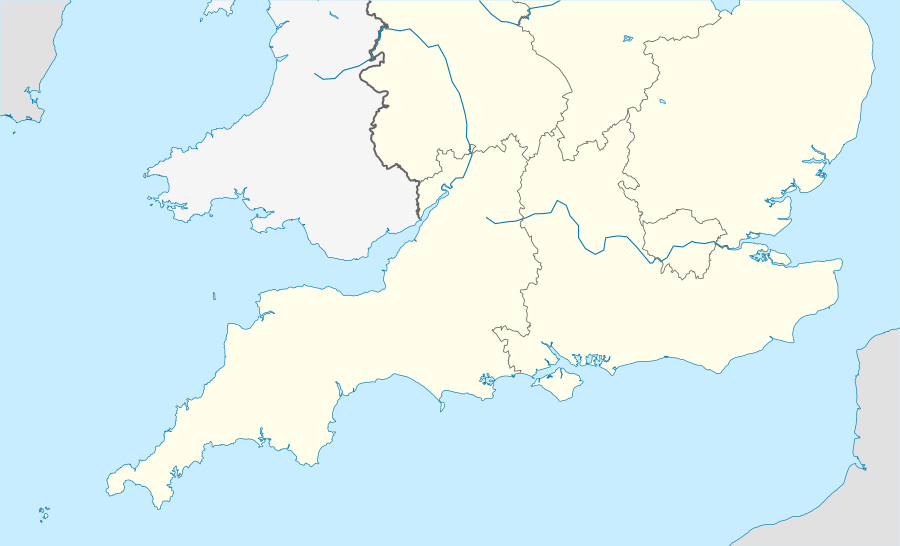
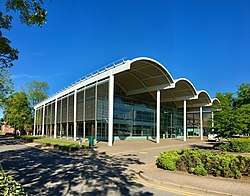
Cranfield campus is approximately 50 miles (80 km) north of central London and adjacent to the village of Cranfield,[13] Bedfordshire. The nearest large towns are Milton Keynes and Bedford, the centres of which are both about 8 miles (13 km) away. Cambridge is about 30 miles (48 km) east.
Shrivenham is about 73 miles (117 km) west of London, adjacent to Shrivenham village, 7 miles (11 km) from the centre of the nearest town, Swindon, and around 23 miles (37 km) from Oxford.
Bedford, Milton Keynes, Oxford and Swindon all have fast rail services to central London terminuses, good access to the main motorway network and London Heathrow airport.
The Cranfield campus sits within the Cambridge – Milton Keynes – Oxford corridor which plans to link the cities and stimulate economic growth. The proposed corridor includes plans for more than one million new houses by 2050, including up to five new garden towns to be approved;[14] the reestablishment of a strategic railway connecting East Anglia with Central, Southern and Western England, In particular, it plans to build (or rebuild) a new line linking Oxford and Cambridge via Bicester, Milton Keynes (at Bletchley) and Bedford called East West Rail; and plans for a Oxford to Cambridge Expressway which is a proposed grade-separated dual carriageway between Oxford and Cambridge, via (or near) Milton Keynes. There are also plans for a tram system between Milton Keynes and Cranfield University, although this is still at an early planning stage.[15]
Technology Park
There are a number of companies located on the Cranfield University Technology Park ranging from large international companies to small start-ups. Major companies on the park include:
- The Nissan Technical Centre[16] Europe, which designs and develops cars for the European market. The NTC Europe facility occupies 19,700 square metres (0.0076 square miles) of the Technology Park, representing an investment of £46m by Nissan.
- Innovation Centre: the Technology Park is also the location for a large number of smaller companies.
Prior to 2016:
- Trafficmaster plc[17] occupied a 10-acre (40,000 m2) site for its European Headquarters. A leading company in telematics, Trafficmaster's advanced technology enables cars and roads to be used more efficiently.
An extension to the Technology Park was completed in 2008. A new Aerospace Park on the north-eastern part of the campus is planned.
Organisation and governance

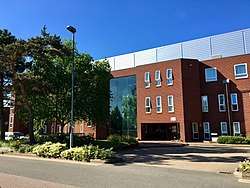
Schools
The academic schools are:
- School of Aerospace, Transport and Manufacturing, known as SATM, incorporating the original College of Aeronautics, has a wide range of experimental research facilities for masters and doctoral students and commercial clients;
- School of Water, Energy and Environment, known as SWEE;
- School of Management, known as SoM;
- Cranfield Defence and Security, known as CDS, at the Defence Academy of the United Kingdom's Shrivenham site (formerly the Defence College of Management and Technology/Royal Military College of Science).
Chancellors
- 1969–1997: Harold Roxbee Cox, Lord Kings Norton
- 1998–2010: Richard Vincent, Lord Vincent of Coleshill
- 2010–present: Baroness Young of Old Scone
Vice-Chancellors
- 1970–1989: Henry Chilver, Lord Chilver
- 1989–2006: Frank Robinson Hartley
- 2006–2013: Sir John (James) O'Reilly[18][19]
- 2013–present: Sir Peter Gregson[20]
Academic disciplines
Cranfield University’s specialist areas of focus, or Cranfield themes, aims to bring a range of academic disciplines together in order to tackle the grand challenges facing the world within a range of industrial and commercial sectors. These are Water, Agrifood, Energy and Power, Aerospace, Manufacturing, Transport Systems, Defence and Security and Business/Management.
Within Cranfield University’s postgraduate environment, the academic disciplines work closely together, blending as they do in the commercial world and industry to deliver real world solutions.[21]
- Aeronautical engineering
- Agriculture and agrifood
- Automation and control systems
- Business and management
- Chemical engineering
- Civil engineering
- Clean energy
- Computer sciences
- Cyber Security
- Design and innovation
- Ecology and sustainability
- Economics and finance
- Electrical and electronic engineering
- Energy and power
- Engineering
- Environmental sciences
- Geography
- Geosciences
- Instruments and instrumentation
- Design and innovation
- International relations
- Life sciences
- Manufacturing engineering
- Materials sciences and engineering
- Mathematics and statistics
- Mechanical engineering
- Mechanics
- Meteorology and atmospheric sciences
- Military sciences
- Physics
- Plant and soil science
- Psychology
- Renewable energy
- Robotics
- Social sciences
- Systems sciences
- Transportation science and technology
- Water sciences
Academic profile
Reputation and rankings
Global rankings | ||
| CWTS Leiden[22] (2018) | 337 | |
|---|---|---|
| Financial Times[23] (2018, world) | 61 |
|---|---|
| Bloomberg Businessweek[24] (2017, world) | 20 |
| Forbes[25] (2017, world) | 10 |
| The Economist[26] (2017, world) | 62 |
| QS[27] (2017, world) | 40 |
| Poets&Quants[28] (2017, world) | 13 |
| Financial Times[29] (2018, national) |
7 |
| Bloomberg Businessweek[24] (2017, national) | 6 |
| Forbes[25] (2017, national) | 3 |
| The Economist[30] (2017, national) |
6 |
Cranfield University consistently performs well in the major school and programme specific rankings, reinforcing its position as a top global university.
As an exclusively postgraduate university, Cranfield University is excluded from the Times Higher Education World Rankings, The Times World Rankings, The Complete University Guide and The Guardian, which focuses on helping prospective undergraduate students to compare universities. As the university is postgraduate, direct comparison with undergraduate institutions is difficult. Some key facts and figures are:
- Cranfield’s staff:student ratio is second among UK universities.[31]
- Cranfield University are in the top 1% of institutions in the world for alumni who hold CEO positions at the world's top companies according to the Centre for World University Rankings, 2017.[32]
- Cranfield School of Management was ranked 3rd best European Business School within the UK and 13th within Europe in 2008.[33] Its MBA is ranked 37th in the world according to the Economist Intelligence Unit (2013).[34] The Financial Times ranked Cranfield's MBA 38th best in the world in 2013.[35]
- Cranfield University was ranked 27th in the world for mechanical, aeronautical and manufacturing engineering by the QS World University Rankings in 2015.[36]
- 54% of all aerospace engineering postgraduates and 25% of all agricultural and environmental sciences postgraduates in the UK graduate at Cranfield.[31]
- Over 10% of the UK’s engineering and sciences PhDs are awarded by Cranfield.[31]
- Cranfield has received the Queen's Anniversary Prize five times: in 2005 for Further and Higher Education for the Fellowship in Manufacturing Management (FMM) programme; in 2007 for its role in humanitarian demining;[37] in 2011 for contribution to aviation safety through research and training in accident investigation;[38] in 2015 for its work in water and sanitation;[39] and in 2017 for its research and education in large-scale soil and environmental data for the sustainable use of natural resources.[40]
- Students on Cranfield's Global Security programme were awarded the Imbert Prize in 2006,[41] 2008[42] and 2009[43] for the development of ideas for the advancement of risk and security management in the UK.
Admissions
In 2015/16, 49% of Cranfield University's students were from the United Kingdom, 25% from Europe and 26% from the rest of the world. Cranfield University's student to staff ratio is 5:1, second among all UK universities.[32]
More than half of Cranfield University's students are over 30 years of age.[32]
Partnerships
Cranfield University has strong links with business, industry and governments. Cranfield University has mutually beneficial relationships with nearly 1,500 organisations around the world including small owner-managed SMEs to large multinational conglomerates; British and international universities, non-government organisations and governments. Some of Cranfield's close partnerships include Airbus, Rolls-Royce Group, Grant Thornton, BAE Systems, Boeing, Lockheed Martin, Ford, BP, British Airways, PWC, L'Oréal, Royal Dutch Shell, Jaguar Land Rover, Oracle Corporation, PepsiCo, Unilever, to name just a few.[44]
Cranfield University has close links with more than 130 universities in the Americas, Asia and Oceania, Europe, Middle East and Africa.[45] The University collaborates with the Singapore University of Social Sciences (SUSS) on SUSS’s BEng Aerospace Systems[46].
The IMRC - Innovative Manufacturing Research Centre at Cranfield University is a project funded by the EPSRC (Engineering and Physical Sciences Research Council) undertaking research that addresses issues identified in the UK government’s High Value Manufacturing strategy.[47]
Student life
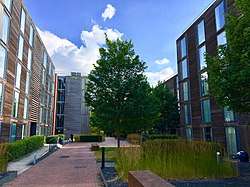
Facilities at the Cranfield University campus include a sports centre, which incorporates a fitness centre and aerobics studio, playing fields, sports pitches and several tennis courts. There are wide range of shops, restaurants, cafes and bars available for students and staff.
Students' Union
Cranfield Students Association (CSA) is the students' union and runs the main student bar, cafe and shop on the Cranfield campus. Nithya Subramanian is the President of Cranfield Students Association for 2018/2019.
The CSA is run by a team of elected students and supported by a small team of staff. The aim of the CSA is to support and represent Cranfield University students, promote student welfare and organise social, cultural and sporting activities.
Student Accommodation
At the Cranfield University campus there are a wide range of accommodation options for full time students, from halls of residence to shared houses, apartments for couples and houses for families.
For part time students, there are two options available - the 186 room Cranfield Management Development Centre and the 114 room Mitchell Hall, both of which are situated on campus.
Notable alumni
Cranfield University has a number of notable academic staff and alumni, including politicians, business people, entrepreneurs, engineers, authors, and TV personalities.
Cranfield University is in the top 1% of institutions in the world for alumni who hold CEO positions at the world's top companies according to the Centre for World University Rankings, 2017.[32]
 Antony Jenkins – Former Group Chief Executive, Barclays
Antony Jenkins – Former Group Chief Executive, Barclays Warren East – CEO, Rolls-Royce Holdings
Warren East – CEO, Rolls-Royce Holdings Winnie Byanyima - Executive director of Oxfam International
Winnie Byanyima - Executive director of Oxfam International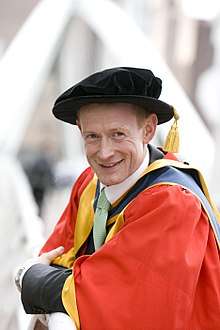
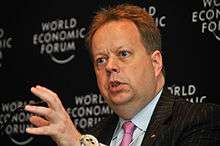 Andy Palmer - CEO, Aston Martin
Andy Palmer - CEO, Aston Martin
- Nick Jenkins – Founder of online greetings card retailer Moonpig, former "dragon" on the BBC Two business series Dragons' Den
- Karan Bilimoria – Founder and Chairman, Cobra Beer Ltd[48]
- Crispin Blunt – Member of Parliament for Reigate
- Andy Bond – Former CEO, Asda
- L. J. Clancy – author of Aerodynamics (1975)
- Warren East – CEO, Rolls-Royce Holdings
- Andy Palmer - CEO, Aston Martin
- Andy Harrison – CEO, Whitbread
- Nader Al-Dahabi - Former prime minister of Jordan
- John Hull – Professor of Derivatives and Risk Management at the University of Toronto
- Antony Jenkins – former Group Chief Executive, Barclays
- Ahmed Aly - CEO, Nile Air
- Martin Lamb – Chief Executive, IMI plc
- Riz Lateef – Main presenter, BBC London News[49]
- Charlie Mayfield – Chairman, John Lewis Partnership
- John McFarlane – Executive Chairman, Barclays[50]
- Lara Morgan – Founder, Company Shortcuts
- Ted Tuppen – CEO, Enterprise Inns Plc
- Sarah Willingham – founder of letssavesomemoney.com, former owner of Bombay Bicycle Club and former "dragon" on the BBC Two business series Dragons' Den
- Francois Caudron - Vice President of Marketing, Airbus
- Akinwunmi Ambode - Governor Lagos State, Nigeria
- Juan Rafael Elvira Quesada - Served as Secretary of the Environment and Natural Resources
- Nigel Doughty - Former co-chairman and co-founder of Doughty Hanson & Co
- Siddhartha Lal - Chief executive officer and Managing Director of Eicher Motors, and Chairman & Managing Director of VE Commercial Vehicles
- Michael Bear (Lord Mayor) - The 683rd Lord Mayor of London
- Samer Majali - Former CEO of Royal Jordanian airlines
- Winnie Byanyima - Executive director of Oxfam International
- Clifford Braimah - Managing Director Ghana Water Company Limited
Gallery
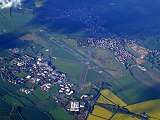 Cranfield University Birdseye view
Cranfield University Birdseye view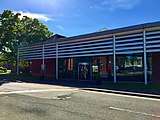 Cranfield University CMRI
Cranfield University CMRI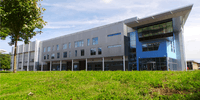 Cranfield University IMEC
Cranfield University IMEC.jpg) Cranfield University Sports Hall
Cranfield University Sports Hall C4D Building, the Centre for Creative Competitive Design, opened 2010
C4D Building, the Centre for Creative Competitive Design, opened 2010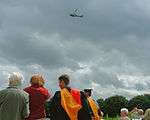 Army helicopter display team, graduation 2004
Army helicopter display team, graduation 2004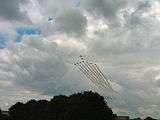 RAF Red Arrows display team, Shrivenham graduation, July 2003
RAF Red Arrows display team, Shrivenham graduation, July 2003- The new Vincent Building's interior, June 2008
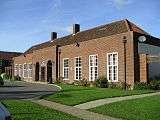 Lanchester Hall
Lanchester Hall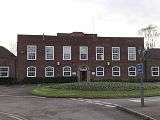 Kent House
Kent House Cranfield Library
Cranfield Library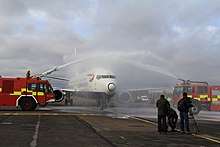 Boeing 737 G-DOCB arrives at Cranfield University
Boeing 737 G-DOCB arrives at Cranfield University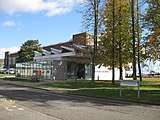 Cranfield University C4D Centre for Design
Cranfield University C4D Centre for Design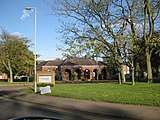 Cranfield University
Cranfield University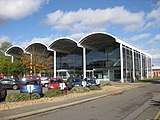 Cranfield University Library
Cranfield University Library
See also
- Cranfield University campus maps - updated 2016
- Academics of Cranfield University
- Alumni of Cranfield University
- Facility for Airborne Atmospheric Measurements
- Royal School of Military Survey
- Cranfield Institute
- Cranfield experiments
- Map sources for Cranfield University
References
- ↑ "The Arms of the University". Cranfield University. Retrieved 1 July 2017.
- 1 2 3 4 5 Swain, Harriet (23 January 2012). "Is Cranfield's postgraduate-only university a model for the future?". The Guardian. Retrieved 28 December 2017.
- 1 2 3 4 5 "Cranfield University". The Independent. 23 July 2014. Retrieved 28 December 2017.
- 1 2 3 4 5 "Cranfield College of Aeronautics history". Cranfield University. n.d. p. 1. Retrieved 28 December 2017.
The institution ... was granted university status in 1969 becoming the Cranfield Institute of Technology and it changed its name to Cranfield University in 1993
- ↑ Cranfield University press release 18 February 2013, accessed 22 February 2013
- ↑ "2016/17 Students by HE provider, level, mode and domicile" (CSV). Higher Education Statistics Agency. Retrieved 25 March 2018.
- ↑ "How to find us - Cranfield University at Shrivenham". Cranfield University. Retrieved 1 July 2017.
- ↑ "Cranfield University History". Cranfield University. Retrieved 22 May 2018.
- ↑ "History and heritage". Cranfield University. Retrieved 1 July 2017.
- ↑ "Cranfield University". Lord Kings Norton. Cranfield University. Retrieved 1 July 2017.
- 1 2 "Silsoe college remembered on new homes estate". Bedford Today. 15 December 2013. Retrieved 1 July 2017.
- ↑ "Analysis: Military redeploys intellectual might". Times Higher Education. Retrieved 26 December 2009.
- ↑ "Cranfield Village Newsletter including a history and information on the airfield". Cranfield Parish Council. Archived from the original on 7 June 2007.
- ↑ "Sajid Javid exclusive interview: Garden towns and expressway to sprout up in Oxbridge corridor". The Times. Retrieved 23 May 2018.
- ↑ "National Infrastructure Commission - Cambridge, Milton Keynes and Oxford Future Planning Options Project Final Report" (PDF). National Infrastructure Commission. Retrieved 23 May 2018.
- ↑ "Nissan UK". Nissan, UK. Retrieved 10 June 2007.
- ↑ "Trafficmaster plc". Trafficmaster plc. Retrieved 10 June 2007.
- ↑ "Sir John O'Reilly". Engineering and Physical Sciences Research Council, UK. Archived from the original on 7 June 2007. Retrieved 9 June 2007.
- ↑ "Sir John O'Reilly". Cranfield University - Biography. Archived from the original on 18 July 2009. Retrieved 18 March 2009.
- ↑ "Professor Sir Peter Gregson FREng". Cranfield University - Chief Executive and Vice-Chancellor. Retrieved 27 February 2014.
- ↑ "Cranfield University Academic Disciplines". Cranfield University. Retrieved 22 May 2018.
- ↑ "CWTS Leiden Ranking 2018 - PP top 10%". CWTS Leiden Ranking 2018. Retrieved 16 May 2018.
- ↑ "Financial Times Ranking 2018". Financial Times Ranking 2018. Retrieved 22 May 2018.
- 1 2 "Bloomberg Businessweek Ranking 2017". Bloomberg Businessweek Ranking 2017. Retrieved 22 May 2018.
- 1 2 "Forbes Ranking 2017". Forbes Ranking 2017. Retrieved 22 May 2018.
- ↑ "The Economist Ranking 2017". The Economist 2017. Retrieved 22 May 2018.
- ↑ "QS Ranking 2017". The QS University Guide 2017. Retrieved 22 May 2018.
- ↑ "Poets&Quants Ranking 2017". Poets&Quants. Retrieved 22 May 2018.
- ↑ "Financial Times league tables 2018". The Financial Times. 22 May 2018. Retrieved 22 May 2018.
- ↑ "The Economist University Guide 2017". The Economist. Retrieved 22 May 2018.
- 1 2 3 "Cranfield University 2008 Prospectus". Cranfield University. Archived from the original on 6 February 2009. Retrieved 23 September 2008.
- 1 2 3 4 "Cranfield University Fact and Figures". Cranfield University Fact and Figures. Retrieved 22 May 2018.
- ↑ "Financial Times 2008 rankings". Financial Times. 2008. Retrieved 10 October 2009.
- ↑ Economist Intelligence Unit. "Which MBA - 2007 rankings -The Economist".
- ↑ Financial Times. "Global MBA rankings".
- ↑ QS World Rankings. "QS World Rankings by Subject 2015".
- ↑ The Queen's Anniversary Prize for Further and Higher Education
- ↑ 2011 Queens Anniversary awards
- ↑
- ↑ "Cranfield University Rankings and Awards". Cranfield University Rankings and Awards. Retrieved 22 May 2018.
- ↑ Sims, Brian (3 August 2006). "Burrill, Cahalane and Finch win Imbert Prizes". Info4Security. Archived from the original on 13 July 2011. Retrieved 26 June 2009.
- ↑ "ASC lunch". Professional Security Magazine. 30 June 2008. Archived from the original on 3 October 2011. Retrieved 26 June 2009.
- ↑ Sims, Brian (30 June 2009). "Policing with a Brain: the 2009 ASC Annual Luncheon". Info4Security. Archived from the original on 13 July 2011. Retrieved 30 June 2009.
- ↑ "Cranfield University International Partnerships (Who we work with)". Cranfield University International Partnerships. Retrieved 22 May 2018.
- ↑ "Cranfield University International Partnerships". Cranfield University International Partnerships. Retrieved 22 May 2018.
- ↑ "Collaborations with Overseas Universities". SUSS. 29 May 2018.
- ↑ Government Opportunities retrieved 11 April 2013
- ↑ "Karan Bilimoria - Founder of Cobra Beer". London Speaker Bureau.
- ↑ "London's Most Influential People 2008". London Evening Standard.
- ↑ "John McFarlane OBE, awarded honorary degree from Cranfield". Cranfield School of Management.
Further reading
- Barker, Revel (1996). Field of Vision; Cranfield University: the first fifty years. Cranfield University Press. ISBN 1-871315-60-3.
External links
| Wikimedia Commons has media related to Cranfield University. |